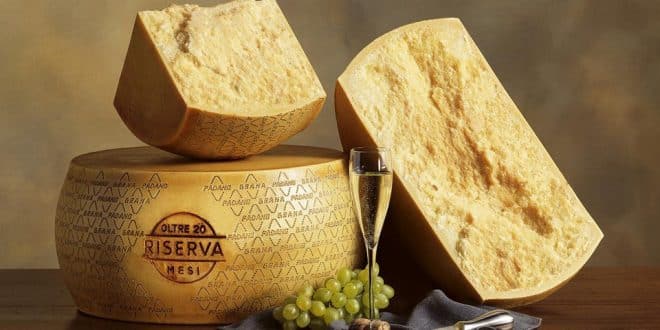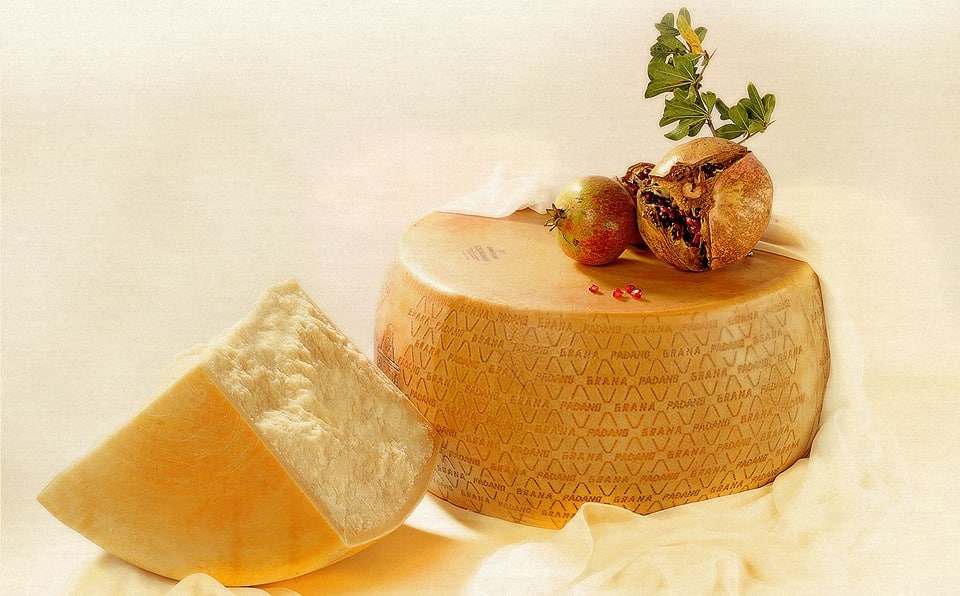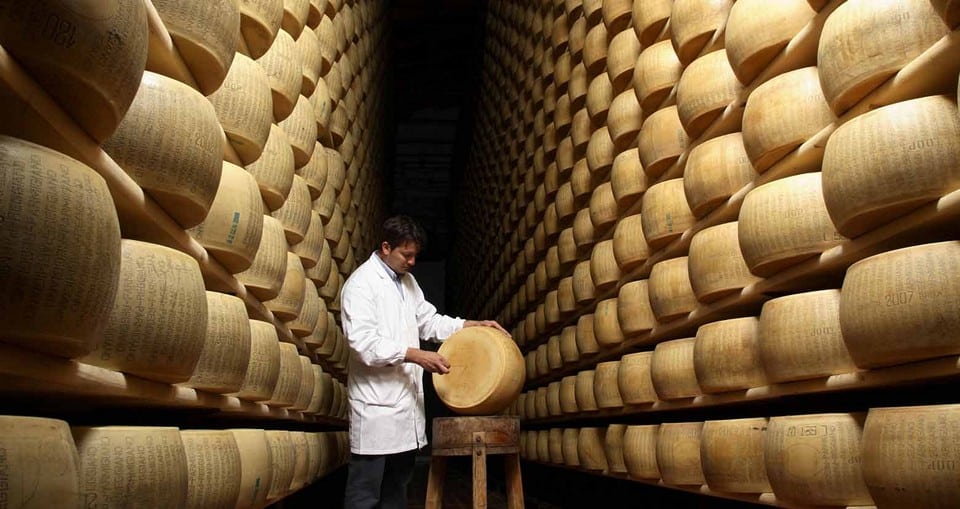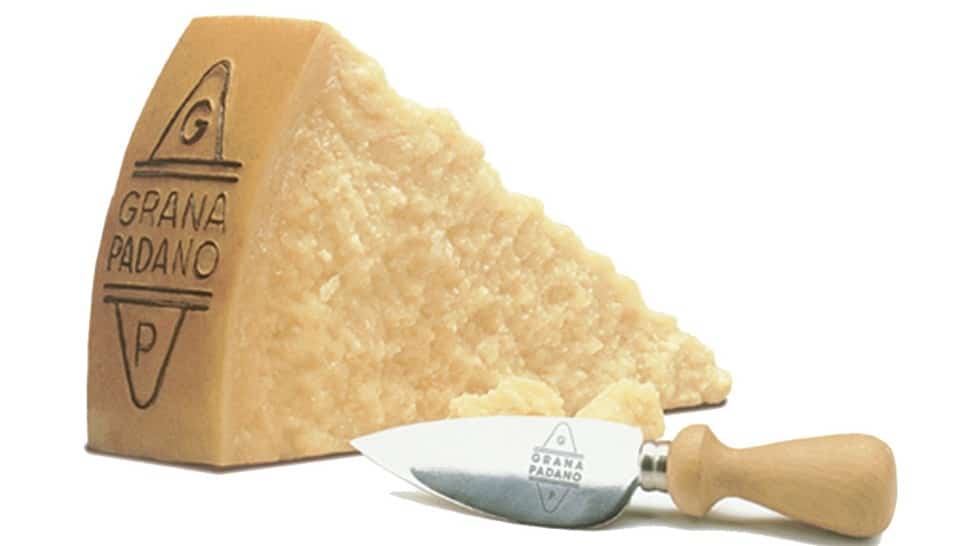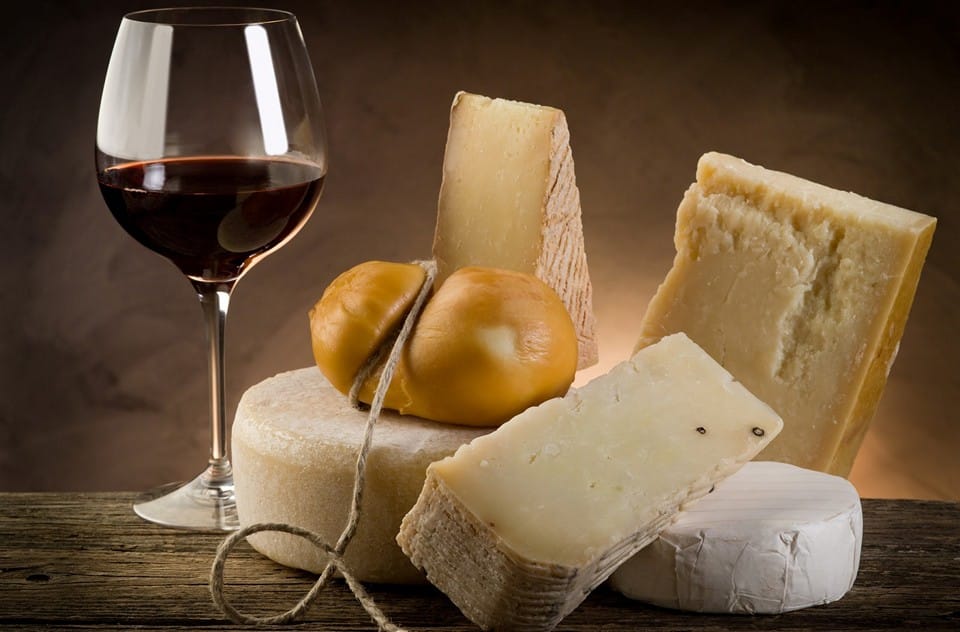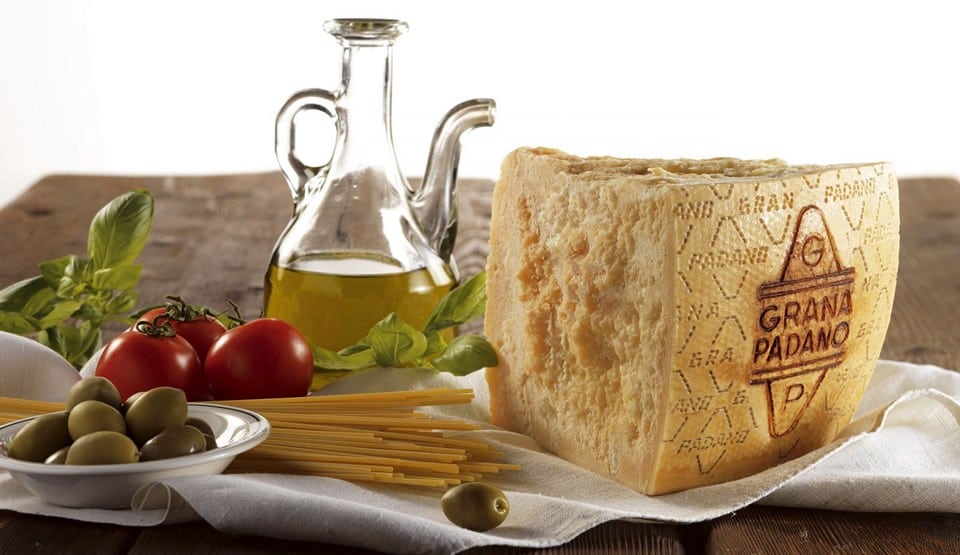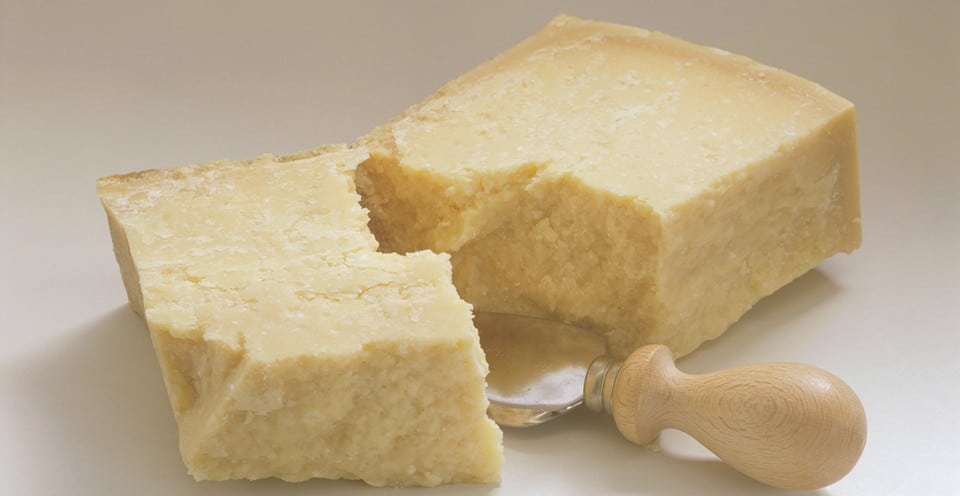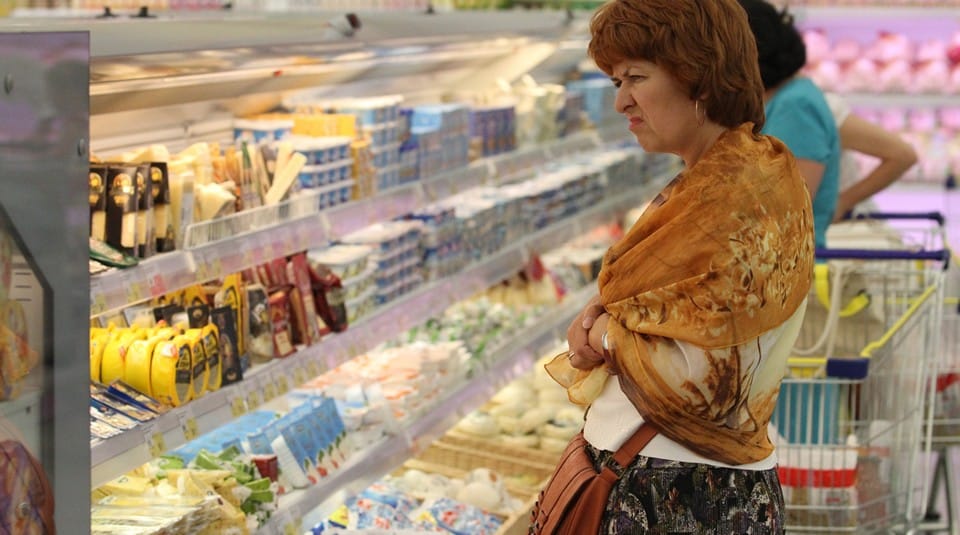Living in the shadow of a famous relative can be challenging, as Grana Padano cheese knows all too well. This hard Italian cheese, often mistaken for Parmesan, has its own unique qualities and deserves recognition. Let’s delve into its history.
Page Contents
How was Grana Padano Born and Lived
According to the tale, Grana Padano originated around the year 1000 in the rural areas near the Po River. Back then, food was not as abundant as it is today, and every product from the farm was utilized. With the development of livestock farming, the issue of using surplus milk arose. Fresh cheese would spoil quickly, prompting the idea of producing a hard cheese that could be stored for longer periods.
Mass production of Grana Padano is believed to have begun in 1135 within the monastery of Chiaravalle. Monasteries can be rightfully considered the pioneers of large-scale cheese making.
The monks referred to this cheese as “caseus vetus,” meaning “old cheese” in Latin. However, most common consumers were not familiar with Latin and gave it a different name based on its grainy texture. Thus, the cheese acquired the new name “Formaggio di Grana” or simply “Grana,” a name that has survived to this day.
There are records suggesting that the oldest Grana Padano originated from Lodi, but mentions also include Milan, Parma, Piacenza, and Mantua.
Over time, this cheese gained significant value, and its popularity grew rapidly. For instance, in 1504, Isabella d’Este shared half a wheel of Grana Padano with her father and brother, telling them, “Half the cheese to each of you because its value outweighs its quantity!”
Grana Padano became so sought after that in 1525, a farm overseer lamented how difficult it was to obtain “eight pieces of good three-year-old cheese” that had been promised to the King of Spain.
For the following three centuries, no significant changes were made to its production process. It was only after 1837 that the first scientific research institutes on cheese-making were established. The major changes in production occurred on June 1, 1951, with the signing of an agreement that established precise production rules and quality characteristics for the cheese.
It was after this agreement that two separate varieties of Grana emerged: Grana Lodigiano, later known as Grana Padano, and Parmigiano-Reggiano. On October 30, 1955, a decree by the President of the Republic defined the “production methods, characteristics, and production areas” of these cheeses.
In 1996, Grana Padano obtained the status of a cheese with a protected designation of origin (DOP).
How do they do
The production rules for Grana Padano cheese have remained almost unchanged for nearly a thousand years. It is produced in many provinces within the five regions of Italy: Emilia-Romagna, Lombardia, Piemonte, Trentino-Alto Adige, and Veneto.
Special requirements are placed on the milk used for the cheese, although they are not as strict as those for Parmigiano Reggiano cheese. At least 75% of the feed for the dairy cows must be obtained within the production area. To make Grana Padano, partially skimmed milk from no more than two milkings is used.
The cheese-making process takes place in copper or copper-lined vats that resemble inverted bell shapes with a volume of 1000 liters. From one vat, two cheese heads are obtained, which the masters call “twins.”
The milk is heated to 31-33 degrees Celsius, and whey starter, remaining from the cheese-making process of the previous day, and calf rennet obtained from calves are added. The mixture is left to coagulate for 45-60 minutes. The curd is then cut and stirred while continuing to heat it to 53-56 degrees Celsius. The curds settle at the bottom of the vat for about 70 minutes.
Operators, using wooden paddles and a fabric called “schiavino” (which translates to “slave” in Italian), lift the curd from the vat and divide it into two equal parts. Each half is wrapped in linen cloth.
The new cheese is placed in wooden molds, although nowadays Teflon molds are also used, and firmly pressed with a heavy disk made of the same material. After approximately 12 hours, plates with markings are inserted between the cheese and the mold: a four-leaf clover, a serial number, the province code, the month of production, and dotted diamonds (the symbol of Grana Padano) distributed across the surface. A layer of casein is then added, which becomes part of the cheese rind.
After 24 hours, the cheese is placed in a stainless steel, perforated, slightly convex mold, which gives it its final shape in a couple of days.
At this point, the Grana cheese is ready for brining and is placed in salted water for 16-25 days (the time depends on the size, shape, and desired saltiness). After drying in special rooms, the aging process begins, which lasts from 9 to 24 months. It takes place in rooms equipped with proper ventilation, temperature, and humidity control systems. Throughout this period, the cheese is rubbed and turned every 15 days. These operations, previously done manually, are now fully automated.
At the end of the process, the quality of the cheese is assessed using special tools (a small hammer, a needle, and a probe) in the presence of experts from the Consortium. Heads that meet the necessary parameters receive the “Grana Padano” stamp, without which the cheese is not considered authentic and cannot be sold under that name.
Each cheese head must weigh between 24 and 40 kilograms. Approximately 15 liters of milk are required to produce 1 kilogram of Grana Padano cheese.
In the past, the cheese was distinguished by quality depending on the season of production:
- “Vernengo” – produced from December to March.
- “Di testa” – made from April to June (considered the best).
- “Tardivo o terzolo” – a product from October to November.
Such division was based on the quality of feed that cows received in different months. This distinction is now overcome as the animals are primarily fed with uniformly prepared hay. As a result, we have uniformly high-quality Grana Padano throughout the year.
How to eat Grana Padano and store it
Grana Padano is undoubtedly a distinguished guest on any table and in any form, whether grated flakes or bite-sized slices, in main dishes or even desserts. It possesses a spicy, moderately salty taste with pronounced nutty notes. It serves as an ingredient in both traditional Italian dishes and newly invented recipes.
The cheese enhances the flavor of any pasta dish and intensifies the taste of meat, whether served cold or hot. Grated Grana Padano amazingly transforms the aroma of baked fish or braised vegetables.
You can find Grana Padano cheese in three degrees of maturity on the counters:
- 9-16 months: The cheese has a grainy texture, a pale milky color, and a delicate taste. It pairs well with chilled fruity white wines.
- 16-month cheese: The texture becomes more grainy, the sweetness less noticeable, and the taste sharper and more pronounced. This option complements young red wines with a long aftertaste.
- Over 20 months or “Riserva”: This is a relatively young variety designed for true connoisseurs. The texture is very fragile, the color is pale yellow, and the taste is full, pungent, and spicy. It is chosen as an aperitif with wines that have a sweet, velvety taste, high tannin content, and high alcohol content. For example, sweet dessert wines like Passito. It also pairs well with any nuts and fruits (grapes, figs).
It is worth mentioning that Grana Padano wonderfully enhances any dish that requires a hard cheese. You can read about the differences between Grana Padano and Parmesan in our article “Parmesan – the King of Cheeses.”
Recipe for Cheese “Lollipops”:
We’ll share with you a recipe for a unique treat. All you need is:
- 240 g of Grana Padano cheese
- 70 g of shelled pistachios
- 20 g of paprika
- 70 g of shelled pumpkin seeds
Grate the cheese and chop the pistachios and pumpkin seeds. On baking paper, shape three flat circles (approximately 10 cm in diameter) from the cheese. Sprinkle the remaining ingredients on top and bake in the microwave at maximum power for one minute, placing a wooden skewer in the center of each circle. Let them cool down and serve these unusual “lollipops” as an appetizer, while paying attention to the delighted faces of your guests.
The best way to store Grana Padano is in the coldest part of the refrigerator. If you haven’t used the entire cheese, it’s recommended to place it in a vacuum container or tightly wrap it in plastic wrap to prevent contact with moist air.
In principle, its shelf life is not limited under the correct conditions since the extended aging process results in a moisture content that inhibits the growth of pathogenic bacteria.
Caloric Content and Benefits
Grana Padano cheese has unique nutritional characteristics due to the use of natural, high-quality ingredients and its long maturation process. The caloric content of 100 grams of cheese is 384 kcal, which contains:
- Protein: 33 grams
- Fat: 28 grams
- Carbohydrates: 0 grams
- Cholesterol: 140 mg
- Calcium: 1165 mg
- Phosphorus: 692 mg
- Sodium chloride: 1.6 grams
- Potassium: 120 mg
- Magnesium: 63 mg
- Zinc: 11 mg
- Iron: 140 mcg
- Copper: 500 mcg
- Selenium: 12 mcg
- Iodine: 35.5 mcg
Due to its long maturation, Grana Padano is rich in modified proteins that are easily digested and quickly absorbed. It also contains free amino acids that stimulate the activity of digestive enzymes. This fact makes the cheese an indispensable product for athletes, children (as an introduction to cheese in their diet), and pregnant women.
The minerals present in its composition are highly valuable for the health of bones, muscles, and teeth, which is particularly important for older individuals.
Approximately 40% of the fats found in the cheese are unsaturated. These compounds support heart and vascular health, participate in the synthesis of many hormones, provide protection against inflammatory processes, and form the foundation of healthy skin and hair.
The calcium content in just 50 grams of cheese covers 60% of the daily norm for adults, 50% for elderly individuals, and 43% for teenagers and pregnant women. This mineral plays an important role in muscle contraction, cellular permeability, and bone integrity.
Additionally, Grana Padano provides the body with:
- Phosphorus, which is essential for dental health.
- Iodine, an important component for the proper functioning of the thyroid gland.
- Copper and zinc, which help prevent cell aging and maintain muscle tone.
- Selenium, which normalizes the functioning of the immune and cardiovascular systems.
- Magnesium, which catalyzes the activity of certain enzymes involved in regulating metabolism.
- The cheese contains 8 vitamins (A, B1, B2, B6, B12, D, PP, E), which can only be obtained through food intake. This combination supports the proper functioning of almost all systems in the human body.
Due to its unique nutritional value, Grana Padano meets all the requirements of a balanced daily diet.
Price in Italy
To truly taste authentic Grana Padano, you simply need to visit Italy. Despite its excellent quality, its price varies significantly compared to Parmesan. In Italian stores, you can purchase it for 6.5-17 Euros per kilogram, depending on its age.
That’s all you could learn about Grana Padano. Hopefully, you’ve noticed that, while not being the king, it is as close as possible to its famous counterpart. Live with love, don’t be afraid to try new things, travel with optimism, and remember: “A penny saved is a penny earned, and Grana Padano is worth five hundred!”
Interesting Facts about Grana Padano
- Grana Padano, a renowned Italian cheese, has a history that dates back nearly 1,000 years, making it one of the oldest cheeses in the world.
- Produced exclusively in the Po River Valley in northern Italy, Grana Padano is protected by strict regulations and can only be made using traditional methods.
- It takes a full year of aging to develop the distinctive flavor and granular texture of Grana Padano, resulting in a cheese that is rich, complex, and full-bodied.
- Grana Padano is a versatile cheese that can be enjoyed in various ways. It is commonly grated over pasta, risotto, and salads, but it can also be enjoyed on its own or paired with fruits, nuts, or a glass of wine.
- The aging process of Grana Padano contributes to its nutritional profile, as it becomes lactose-free and rich in protein, vitamins, and minerals, including calcium and phosphorus.
- Grana Padano has been recognized with the PDO (Protected Designation of Origin) status, ensuring its authenticity and origin. Look for the fire-branded “Grana Padano” marking on the rind to guarantee its quality.
- The production of Grana Padano follows strict guidelines, including the use of raw cow’s milk, natural whey starter, and the absence of additives or preservatives, resulting in a cheese that is natural and authentic.
- Each wheel of Grana Padano undergoes meticulous quality control, including sensory and laboratory tests, to ensure its adherence to the highest standards of taste and quality.
- Grana Padano is not only delicious but also a symbol of Italian culture and tradition. Its production represents a long-standing heritage passed down through generations of cheese artisans.
- The name “Grana” refers to the grainy texture of the cheese, while “Padano” indicates its origin in the Po River Valley. Together, they represent the essence of this beloved Italian cheese.
 Italy for me From Italy with love
Italy for me From Italy with love

